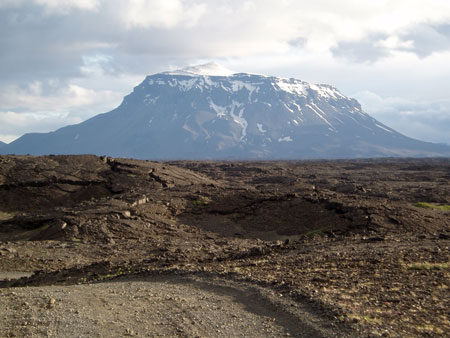Research
Rifting and Volcanism

The North Iceland rift
Magmatism associated with rifting is one of the most important factors in shaping the crust: two-thirds of the earth's crust forms at mid-ocean spreading centres, and many of earth's most spectacular features, including flood basalts and volcanoes, result from interaction between rifting and mantle melting. Relatively small changes in mantle temperature have a profound effect on the volume and composition of melts produced from that mantle. Understanding these processes is important not only academically, but also for wider social reasons because of the hazards of volcanic eruptions, their impact on global climate change, and their importance in the development of sedimentary basins and continental margins. Much of our understanding of these processes comes from probing the subsurface using seismic methods. My research group acquires state-of-the- art seismic data from both controlled sources and earthquakes, on land and at sea, and at all scales from metre-size observations in boreholes to hundred-kilometre scale transects of rifted continental margins. We seek to apply innovative data processing and modelling methods to maximise the geological constraints that can be inferred from these observations.
Current Research Projects
- Tomographic imaging of melt bodies under active volcanoes in Iceland and New Zealand using large arrays of broad-band seismometers. We have a particular focus currently on the north Iceland volcanic rift, where we have mapped small earthquakes at 12–30 km depth caused by catching melt in the act of intruding into the rift in the normally ductile lower crust near Askja and Bardarbunga.
- Imaging the injection of melt 46 km horizontally along the Bardarbunga-Holuhraun dyke, Iceland in 2014-15, rock failure associated with the melt injection by moment tensor solutions, fluid motion from analysis of tremor, and the ongoing deformation of the Bardarbunga caldera from local seismicity.
- Active tectonics of the Icelandic rift zones.
- Combined ambient noise tomography and receiver function study of the crustal and upper mantle structure of Iceland.
- Detailed properties of basalts, including their attenuative and anisotropic properties.
- Development of improved methods of mapping fluid motions in the subsurface from surface seismic monitoring of hydrofractures in subterranean reservoirs and satellite and GPS monitoring, including Groningen gas field, Netherlands.
- Development of a broader view of the sustainable use of the environment using scientific, social, and ethical insights.
- Research into the responses of people caught up in disasters (including the 2010 Haiti earthquake; Typhoon Yolanda in Philippines; Hurricane Katrina in New Orleans; flooding in Somerset, UK; earthquake in Yogyakarta, Indonesia) using quantitative surveys and ethnographic research methods with the aim of increasing resilience to future events and post-disaster recovery.

